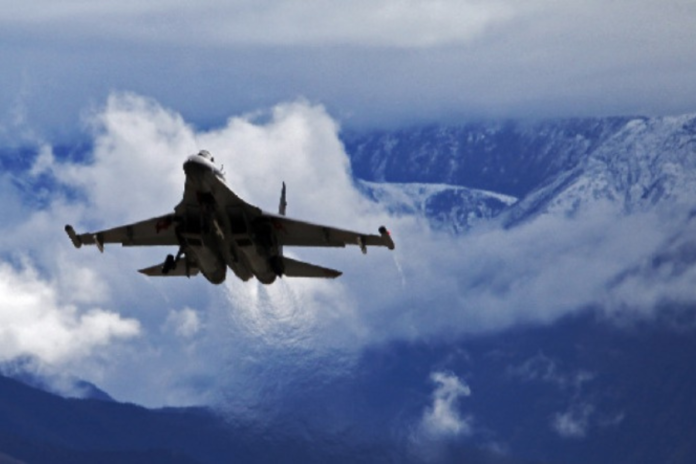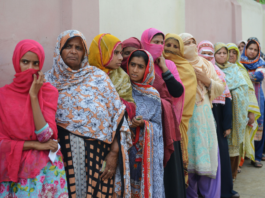
Since the Galwan conflict four years ago, ties between China and India have never been better. There is currently a tentative attempt at reengagement and an uneasy quiet, but there are still many differences between the two Asian titans. Along the Line of Actual Control, China is actively developing infrastructure in Xinjiang and Tibet (LAC). The Chinese seek to escalate the battle by using air force.
Fifth-generation stealth aircraft J-20 from the People’s Liberation Army Air Force (PLAAF) of China were recently stationed at Shigatse Air Base, which is about 150 km from the LAC in Sikkim and about 300 km north of the Indian Air Force’s (IAF) Rafale air base at Hasimara.
China has deployed J-20 fighter aircraft at Hotan Airbase in Xinjiang, 350 km north of Pangong Tso Lake and about 120 kilometers from the claim line of India in Aksai Chin. It’s critical to comprehend the PLAAF’s capabilities and resources at these two strategically significant airbases.
Shigatse (Xigaze) Air Base of China
The second-biggest city in the Tibet Autonomous Region is Shigatse (Xigaze). Located around 180 kilometers west of Lhasa, Shigatse Airbase, also known as the Shigatse Peace Airport, is a dual-use airfield in Tibet. 1968 saw the start of construction, which was finished in 1973. 1973 saw the start of PLAAF operations there, and 2010 saw the start of civil operations. One of the highest airports in the world, it is located 3,782 meters, or 12,408 feet, above mean sea level (AMSL).
It features two concrete runways: the 09/27, which is 5,000 meters (16,404 feet) long, and the 07/25, which is 3,000 meters (9,843 feet) long. Ulyanovsk Vostochny Airport in southwest Russia is the only other public airport in the world with a runway as long as thhe one in Shigatse (Xigaze).
Annually, the airport handles more than 2,000 movements and around 200,000 people. Large amounts of freight are also flown. The second runway, which is shorter, was built in 2017, and Guizhou WZ-7 “Soaring Dragon” unmanned aerial vehicles have been spotted using it.
Six J-20 stealth aircraft were spotted flying out of the airbase in May 2024. Additionally, one KJ-500 Airborne Early Warning and Control (AEW&C) aircraft and at least eight J-10 aircraft were observed stationed at the airbase. Because of Shigatse’s enormous runway, the drawbacks of weight transport during high-altitude airfield operations can be somewhat mitigated.
Importance of Shigatse (Xigaze)
Shigatse is quite close to the IAF’s Hasimara air base (300 km) and the LAC near Sikkim (150 km). The Hasimara Air Base is located in the Chicken’s Neck, often known as the Siliguri corridor. At its narrowest point, the stretch of land is 20 to 22 kilometers. The seven northeastern states and the rest of India are connected by this geopolitical and geoeconomic corridor.
Because it is home to one of the two squadrons of the IAF’s most advanced aircraft, the Rafale, the airbase is extremely important. If this base were to become neutral, even for a brief while, India would be affected.
The small Siliguri corridor becomes more problematic if an antagonistic regime seizes power in Bangladesh. However, India has had to endure a far more hostile East Pakistan. China and India are both much more strong nations now.
Chengdu J-20 ‘Mighty Dragon’ of China
The Chinese twinjet stealth fighter aircraft of the fifth generation is called the Chengdu J-20. The J-20A, which was the first production model, the J-20B, which can vector thrust, and the J-20S, which can team two seats, are the three versions of the aircraft.
China became the second nation in the world and the first in Asia to field an operational stealth aircraft when the aircraft’s first flight took place in January 2011 and the first J-20 combat unit was established in February 2018. As of now, around 250 have been constructed. Every theater command has been assigned a J-20 squadron.
The Type 1475 (KLJ-5) active electronically scanned array (AESA) radar is installed aboard the aircraft. Omnidirectional infrared coverage is provided by six electro-optic sensors, and this coverage is combined with the radar image to improve situational awareness.
With a thrust of 142-147 kN, the Chinese WS-10Cs engine powers the aircraft, which also features serrated afterburner nozzles for improved stealth from the rear. With a thrust of 180 kN, the Shenyang WS-15 is the powerplant that is ultimately intended.
Both precision-guided weapons and long-range air-to-air missiles (PL-12, PL-15, and PL-21) can be stored in the main weapon bay. Smaller lateral weapon bays are capable of housing short-range AAMs (PL-10).
In 2022, 40 to 50 airframes were expected to be produced annually, and in 2023, 100 to 120 airframes. Currently, the PLA Air Force (PLAAF) has about 240 aircraft. By the early 2030s, there may be 1,000 J-20 aircraft in the fleet.
The J-20S model will have two seats. As “loyal wingmen,” the second operator will oversee attack and reconnaissance missions and command unmanned combat aerial vehicles (UCAVs), such as the stealthy Hongdu GJ-11 UCAV and the AVIC Dark Sword.
How does J-20 compare against Rafale?
The Rafale is one of the 4.5-generation aircraft with front-hemisphere stealth capabilities. In terms of weaponry, electronic warfare, and aero-engine dependability, it is significantly superior to the J-20.
The J-20 hasn’t even left China for an air show. It has never engaged in battle. It hasn’t yet participated in any foreign air force exercises. For two decades, Rafale has been proven in combat in Syria, Afghanistan, Mali, Libya, and Iraq. The IAF routinely conducts these exercises with the world’s best air forces; the most recent ones were “Red Flag” in the USA and “Tarang Shakti,” which takes place in India.
How IAF can counter Shigatse (Xigaze) airbase of China
Despite Rafale’s home base being Hashimara, the aircraft will be housed in reinforced shelters. Moreover, all of the aircraft relocate to operational detachments at different bases rather than staying at their home bases. India would use fighter and missile strikes to counter Shigatse, much as China may try to neutralize IAF bases. Shigatse is the only air base in the area; India has many more possibilities for aircraft deployment and dispersal. Because Indian air bases are substantially lower, they can carry more weapons and fuel, enabling them to reach their targets without needing to refuel.
At the eastern air bases of Tezpur and Chabua, the Indian Air Force (IAF) possesses a considerable number of Su-30 MKI squadrons that possess formidable air attack capabilities, including the lethal BrahMos missiles. IAF can obviously launch a lot more missions than PLAAF. The S-400 is one of the important air defense systems that the IAF will also be deploying.
Hotan Air Base of China
In 1957, the Xinjiang autonomous region’s Hotan airfield was constructed, coinciding with China’s initiation of construction of the disputed Aksai Chin Highway (G219) that passes through Indian Ladakh. At 4,672 feet (1,424 m) AMSL, the airfield is elevated. It features two 1,299-foot parallel concrete runways and a 3,200-meter (10,499-foot) wide parallel taxiway. The yearly capacity of the civil airport is around 1.5 million passengers.
Hotan is located 270 km northeast of Karakoram Pass and about 130 km north of India’s claim line. Leh lies 380 km to the northeast of it. These are not very far for platforms that are in the air.
Chinese military operations in the Ladakh region heavily rely on the Hotan airbase. At Hotan, both runways are currently in use. The second runway is roughly 3,700 meters longer than the first. Along with the new runway, other military structures and aprons have also been constructed. More sortie rates would be possible with the expanded runway.
Since the 2020 Ladakh standoff with India, China has been steadily improving its military readiness. Since 2017, seven strategic dual-use airports have undergone upgrades, including Hotan. At
Hotan Airbase, the Chinese Air Force constructed an underground command and control center. Secure storage areas for ammunition and fuel are present, along with fortified shelters. PLA Rocket Forces (PLARF) dugout locations are available. In addition to Hotan, the Chinese have made significant improvements to their airports in Ngari Gunsa.
Xinjiang province’s Kashgar airfield is another one located a little further north. About 600 miles from Leh and about 300 km north of the Indian claim line. Its runway is 10,499 feet long and is elevated at 4,529 feet (1,380 meters) above sea level. Here, there’s a noticeable PLAAF presence with sunshelters and blast pens that have hardened. Images captured by satellites show fighter aircraft.
IAF options against Hotan airbase
Ambala is home to the nearest Rafale base. From Leh, most IAF fighters can conduct operations. In Thoise, the MiG-29s were put into action. Su-30 MKI can cover the Ladakh region in large numbers. IAF fighters started conducting extensive day and night flights in the area right after the Galwan incident. The IAF has modernized its Mirage-2000 and MiG-29 aircraft. We’re acquiring a couple more. Only 35 kilometers from the LAC, in Nyoma, India, is developing a full-fledged airbase in the interim.
Also Read: India, Japan look beyond China
Overall IAF comparison against PLAAF
The Indian Air Force’s airfields that face China have been upgraded considerably. Additionally, tunnels, bridges, and the road-rail network are developing quickly. India possesses a sizable stockpile of long-range surface and aerial strike weapons.
India has over 28 airfields with a view of the LAC and most of them are located at far lower altitudes than those of China, which has far fewer airfields and those that are located above 10,000 feet. The Border Roads Organisation (BRO) of India is currently working on over 118 projects that include building roads, bridges, and airfields close to the LAC.
The Indian Air Force (IAF) has experienced a great deal of battle, and its pilots have received training and exposure to improve their employment tactics and operational ideas, as well as their skill sets, experience, and combat preparedness. The IAF fought the Kargil War at the foot of the Himalayas. Throughout the year, the IAF conducts logistic support operations in Ladakh, the northeast, and at the highest battleground in Siachen.
Many Indian pundits act like skeptics and present dire predictions for China. India is actually doing pretty well economically, and the IAF will be able to conduct a lot more missions. India needs to increase the number of its fighter squadrons immediately, especially since Pakistan might exploit this and establish a situation where there are threats from two fronts.
The Advanced Medium Combat Aircraft (AMCA), India’s own fifth-generation fighter, is still in the early stages of development and won’t be operationally deployed with the IAF for another 10 to 15 years. The 114 Multi-Role Fighter Aircraft (MRFA) deficit must be filled immediately in order to support the 4.5-generation inventory, even if India must expedite the Light Combat Aircraft and AMCA programs, which are presently experiencing delays.
India needs to improve its information, surveillance, and reconnaissance (ISR) capabilities using planes and satellites. It has to swiftly raise the AEW&C and FRA numbers. In aircraft, atmanirbhrta needs to be accelerated. Now is the time to take action to avoid falling too far behind.



